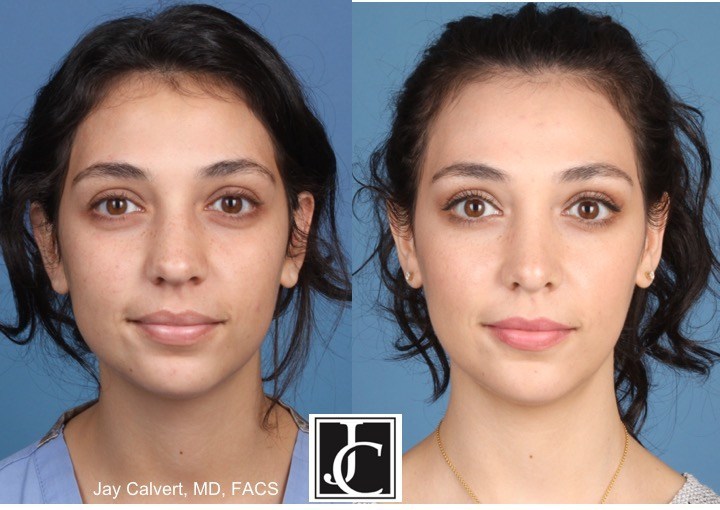Some Known Details About Rhinoplasty Austin Tx
Table of ContentsNot known Facts About Rhinoplasty Surgeon AustinAustin Rhinopasty Surgeon - An OverviewAll about Rhinoplasty Surgeon Austin
Based upon the available location of nasal skin, the cosmetic surgeon chooses the area for the bilobed flap, and orients the pedicle. If the problem remains in the lateral aspect of the nose, the pedicle is based medially. If the problem is at the nasal tip, or at the nasal dorsum, the pedicle is based laterally.

The external semi-circle defines the needed length of the two lobes of the skin flap. The inner semi-circle bisects the center of the initial injury, and continues throughout the donor skin, developing limitation measure of the pedicle common to the two lobes of the flap. The surgeon then draws 2 lines from the peak of the wound; the first line drawn is at an angle of 45 degrees from the long axis of the wound, and the 2nd line drawn is at a 90-degree angle from the axis of the injury.
The delineation of each of the 2 lobes of the flap starts and ends at the inner semi-circle, and encompasses the external semi-circle, to the point where it converges its main axis. The width of the very first lobe is roughly 2 mm narrower than the width of the injury; the width of the 2nd lobe is roughly 2 mm narrower than the width of the very first lobe.
The wound is deepened, to the nasal skeleton, to accommodate the tissue thickness of the bilobed flap (rhinoplasty surgeon austin). Technically, cutting the injury, enlarging it, is more suitable, and safer, than trimming (thinning) the flap to fit the wound. Weakening the donor site for the 2nd lobe permits closing it mostly; it likewise eliminates excess-skin "dog-ears" at the donor site.
II. Nasolabial flap In the 19th century, the surgical methods of J.F. Dieffenbach (17921847) promoted the nasolabial flap for nasal restoration, for which it remains a fundamental nose surgery treatment. The nasolabial flap can be either superiorly based or inferiorly based; of which the superiorly based flap is the more practical rhinoplastic application, because it has a more flexible arc of rotation, and the donor-site scar is unnoticeable.
Excitement About Austin Rhinopasty Surgeon
The blood supply for the flap pedicle are the transverse branches of the contralateral angular artery (the facial artery terminus parallel to the nose), and by a confluence of blood vessels from the angular artery and from the supraorbital artery in the medial canthus, (the angles formed by the conference of the upper Your Domain Name and lower eyelids) (rhinoplasty surgeon austin).
The nasolabial flap is a random flap that is emplaced with the proximal (near) portion resting upon the lateral wall of the nose, and the distal (far) part resting upon the cheek, which consists of the main angular artery, therefore is perfused with retrograde arterial flow. Surgical technique the nasolabial flap The pedicle of the nasolabial flap rests upon the lateral nasal wall, and is shifted an optimum of 60 degrees, in order to avoid the "bridge result" of a flap emplaced throughout the nasofacial angle.
The shape of the skin flap is cut from the injury design template produced by the surgeon. A cut is made to the flap (without an anaesthetic injection of epinephrine), which then is raised and oriented, in an inferior-to-superior instructions, in between the subcutaneous fat and the muscle fascia. The cutting continues till the skin flap can be easily transposed upon the nasal flaw.
The flap then is bent back (shown), and can be thinned (cut) under loupe zoom; nevertheless, a nasolabial flap can not be thinned as quickly as an axial skin-flap. rhinoplasty surgeon austin. After the nasolabial flap has actually been emplaced, the flap donor-site injury is sutured closed. For an injury of the lateral nasal wall that is less than 15 mm broad, the flap donor-site can be closed mainly, with stitches.

Such risks are prevented by advancing (moving) the skin of the cheek towards the nasofacial junction, where it is sutured to the deep tissues. Additionally, a narrow wound, less than 1 mm large can be permitted to heal by secondary intention (self-governing re-epithelialisation). III. The paramedian forehead flap The paramedian forehead flap is the premier autologous skin graft for the restoration of a nose, by replacing any of the visual nasal subunits, particularly regarding the issues of various tissue thickness and skin color.
Restricted length is a practical application limit of the paramedian forehead flap, especially when the client has a low frontal hairline. In such a client, a small more information portion of scalp skin can be consisted of to the flap, however it does have a different skin texture and does continue growing hair; such mismatching is prevented with the transverse emplacement of the flap along the hairline; yet that portion of the skin flap is random, and so risks a greater occurrence of necrosis.
10 Simple Techniques For Austin Rhinopasty Surgeon
Nevertheless, the second stage of the nasal restoration can be carried out with the patient under local anaesthesia. Visually, although the flap donor-site scar heals well, it is visible, and hence challenging to hide, particularly in men. Nose surgery: A paramedian forehead flap style. Surgical method the paramedian forehead flap The surgeon more develops the paramedian forehead flap from a custom-fabricated three-dimensional metal foil design template derived from the steps of the nasal defect to be remedied.
Later on, the distal half of the flap is dissected and thinned to the subdermal plexus. The surgeon fabricates a metal foil template derived from the dimensions of the nasal wound. Applying a Doppler ultrasonic scanner, the cosmetic surgeon recognizes the axial pedicle of the tissue-flap (made up of the supraorbital artery and the supratrochlear artery), typically at the base, beside the medial brow; the point usually is in between the midline and the supraorbital notch.